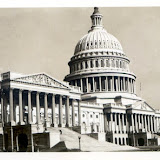“Perhaps, after all, America never has been discovered. I myself would say that it had merely been detected.”
Oscar Wilde; The Picture of Dorian Gray
"Photography," says Walker Evans, "has nothing whatsoever to do with 'Art'. But," he adds quietly, "it's an art for all that."
Time Magazine, Dec 15, 1947
Walker Evans published American Photographs in 1938. Twenty years later Robert Frank gave us The Americans. The photographs in this gallery were taken by unknown photographers during the interim. Some are tiny, measuring 30x50mm, others, slightly bigger, 110x60mm, and were sold as sets in paper wallets for tourists. At first glance they may appear to be the antithesis of what Evans and Frank were trying to achieve but look again and certain connections emerge.
The USA has more monuments than any other country, actual monuments that commemorate particular people and events but others that are more abstract, so to speak. The Capitol building in Washington is a monument to Roman republicanism, the Empire State Building to a mythic relationship between labour and capital. Even geographical features are designated as monuments under federal law. It’s a country where every feature, natural or built by people, has a signpost to a higher meaning. Monuments are scattered throughout Evans’ book, mostly statues in small towns commemorating the Civil War, and always placed in an ironic context, so a marble soldier looks down upon an empty street. When he set out with the intention of documenting the symbols of modern America he knew exactly where to find them but he avoided the Capitol building or the Lincoln Memorial. The ideas they represented were too big and too dubious for someone who wanted to get down, as it were, to street level.
Evans and Frank took nearly identical photographs of the road, at least in the way it stretches through empty space to a vanishing point. Since the invention of the car and the idea of cross-country travel the road has been an irresistible image for American photographers. Commercial photographers sent out to capture scenes for the tourist market got this as much as anyone else. Maybe a photograph of the road winding through the forest along the Mohawk Trail doesn’t have the metaphorical intent Evans and Frank employed but it’s reaching for the same idea. America is restive and in motion. Europeans didn’t often take photos of roads but when they did they usually travelled a short distance before stopping at an identifiable landmark. One of the great things about American photographs, whether taken by Walker Evans or an unknown commercial operator, is that the end is never in sight. The road disappears into the forest. You have no idea where it will take you.
Neither Evans nor Frank would have considered themselves landscape photographers though they could never avoid the subject. Not many can in America unless they hide out in cities. By the 1970s the heroic image of the landscape as exemplified by Ansel Adams (and the photographs of the Grand Canyon here) had run its course. In 1980 Robert Adams, who was no relation by either blood or instinct, produced From the Missouri West, His landscapes looked scrappy, there were no dominant features and they were scarred by human intervention. It seemed he had either reinvigorated landscape photography or put it in its proper place, which is to say the idea of nature as the powerful life force was a lie so long as we kept destroying it. Robert Adams may have been an original but look at the photo here of Crawford Notch in New Hampshire. It isn’t as exquisitely printed as Adams would have it but that isn’t the point. At the very bottom, almost lost in the scrub, runs a line of telegraph poles. Whether the photographer saw them or not, Adams would have. It’s another case common in photography of an innovator being anticipated by a complete unknown.
Which brings us back to Messrs Evans and Frank. If you want to know how good American Photographs and The Americans were, look at photos like these as well and see the similarities. See how they are responding to the mythic image of America?
VIEW THE GALLERY HERE
 |
| AMERICAN VISIONS |



No comments:
Post a Comment
Add comments here